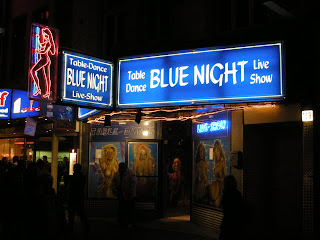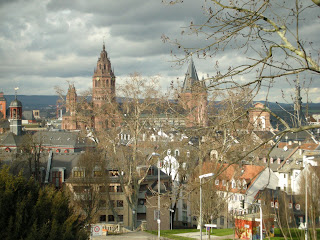Tuesday, March 18, 2008
Away till the 28th Mar
Wednesday, March 12, 2008
Hamburg
I spent my last weekend with about 70 other exchange students as we went to a trip to Hamburg, which is a port city situated at the North of Germany. Hamburg is the second largest city in Germany after Berlin. The journey to Hamburg from Mannheim via bus took us about 9 hours! We left in the middle of the night and arrived the next morning.
The Port of Hamburg
Named Germany's gateway to the world (because Germany is in contentintal Europe, and in the past the only way to access the world by sea would be through the port of Hamburg), it is the second largest port in Europe. From our hostel, we could see a view of the jetty as below. To my dismay, the leftmost tower was under repair!



 What I found very interesting was the day and night concept. When night falls, the room would be darkened and the buildings would light up. So beautiful is this, in the display of Las Vegas at night below. The miniature world brings people to places which they have never been to before as well as bringing back recollections of places that people have been to before.
What I found very interesting was the day and night concept. When night falls, the room would be darkened and the buildings would light up. So beautiful is this, in the display of Las Vegas at night below. The miniature world brings people to places which they have never been to before as well as bringing back recollections of places that people have been to before. At the core of the Innenstadt (inner city) lies the Rathaus (city hall). I was fortunate enough to be there at the right time to get the above shot at dusk. A pity however, that during the next day city trip, we did not stop at the Rathaus to take more pictures. In fact, I did not cover much of the Innenstadt during my trip at Hamburg, which is a pity because there are a lot of beautiful buildings within and I missed quite a lot of them.
At the core of the Innenstadt (inner city) lies the Rathaus (city hall). I was fortunate enough to be there at the right time to get the above shot at dusk. A pity however, that during the next day city trip, we did not stop at the Rathaus to take more pictures. In fact, I did not cover much of the Innenstadt during my trip at Hamburg, which is a pity because there are a lot of beautiful buildings within and I missed quite a lot of them.  I realised that majority of the crowd were middle-aged people above the age of 30s. Young people were almost non-existent. And the interior looked more like a beer hall than a musical theatre. There was no dress code, you could order food and beer and sit in round tables while you watch the musical. After the musical some of us went for dinner.
I realised that majority of the crowd were middle-aged people above the age of 30s. Young people were almost non-existent. And the interior looked more like a beer hall than a musical theatre. There was no dress code, you could order food and beer and sit in round tables while you watch the musical. After the musical some of us went for dinner. 








Eros - the concept of Eros is that women who want to ply their trade will rent a room and then the market themselves via the windows. However after the AIDs scare in the 90s, this Eros was closed down. But of course it does not mean that prostitution does not exist in the area. In fact the alley across the Reeperbahn which the Eros is facing is an alley of glass-windows brothels where the women would stand in front of a the glass panel and passerby can take their pick. I had a look there and found out that the rates were 50 Euros for 20min. So bloody ex! Also, because it is a tourist district, women may tend to want to go and have a peek at the alley too. However this is discouraged by most people even the locals. Firstly it may not be safe and secondly there were incidences that the prostitutes have hurled used condoms at women who wanted to kaypoh because they are not there to frequent their service!
 Another concept which is not explicitly having sex is such of a table dance or live show. Used to be a platform for men for alternative thrills, this is also becoming a curious attraction for tourist. However it is important to know that although entrance is free, the compulsory drinks are exorbitant! A glass of coke which is the cheapest drink costs 10 Euros!
Another concept which is not explicitly having sex is such of a table dance or live show. Used to be a platform for men for alternative thrills, this is also becoming a curious attraction for tourist. However it is important to know that although entrance is free, the compulsory drinks are exorbitant! A glass of coke which is the cheapest drink costs 10 Euros! The Fish market is one of Hamburg's must see on a Sunday morning. Although the market opens till bout 10 plus in the morning, the most happening period is just before sun rises, between 5-6am. With only 2.5 hours of sleep after clubbing the previous night, I forced myself to crawl out of bed and dragged my feet to the fish market, which was thankfully, very near to the hostel.
 It turns out that you don't just buy fish at the fish market. The main highlights are stalls selling fruits and vegetables. What would happen is that the sellers would lay empty baskets, and then start filling them to the brim with different fruits and vegetables, and would sell it for 10 Euros. Not a bad deal actually, by German standards of pricing. And they're really generous. You could ask for one more bunch of bananas for example, and they'd jus go .. OH... Scheiß egal! (oh! shit that's not a problem!)
It turns out that you don't just buy fish at the fish market. The main highlights are stalls selling fruits and vegetables. What would happen is that the sellers would lay empty baskets, and then start filling them to the brim with different fruits and vegetables, and would sell it for 10 Euros. Not a bad deal actually, by German standards of pricing. And they're really generous. You could ask for one more bunch of bananas for example, and they'd jus go .. OH... Scheiß egal! (oh! shit that's not a problem!)Reminds me of the chinese new year stalls at Chinatown earlier this year, where we could eat all we want at the stalls. However here we could not only try out the fruits but also fill the basket to the brim.

 Other finds included German bread, which is a hell of big loaf....
Other finds included German bread, which is a hell of big loaf.... as well as German cheese (Käse)....
as well as German cheese (Käse).... ... Specialities (sweets) from all around the World, Self service
... Specialities (sweets) from all around the World, Self service this building was the original fish market of the past. When it started, all the trading activities would take place inside there. Today all the stalls are set up outside and inside is a beer hall where there are benches to eat and drink as well as .....
this building was the original fish market of the past. When it started, all the trading activities would take place inside there. Today all the stalls are set up outside and inside is a beer hall where there are benches to eat and drink as well as .....


Facing the palace is a castle called the Löwenburg (Lion castle). This castle stands on top of the hill and was quite concealed from the bottom if you'd look up from the palace. Because there is another more prominent structure facing the palace that lies at the centre whereas the Löwenburg is mostly covered by trees. I was glad I saw it from the bottom and made my way up just in time before they close the gates of the castle.





Tuesday, March 4, 2008
Mainz

 I have to admit that this is by far the ugliest Rathaus (city hall) I have ever seen. A check online revealed that the Rathaus was acutally built between 1970 and 1974 by Danish architects using Swedish marble, which probably was like the Esplanade of the day, but thought by many as being not pleasant looking.
I have to admit that this is by far the ugliest Rathaus (city hall) I have ever seen. A check online revealed that the Rathaus was acutally built between 1970 and 1974 by Danish architects using Swedish marble, which probably was like the Esplanade of the day, but thought by many as being not pleasant looking.The Mainzer Dom (Mainz Cathedral)
The thousand year old Cathedral was built around the year 975. It was predominantly Romanesque in style. In front of the Cathedral stands a beautiful monument. Together with the cathedrals in Worms and Speyer (all of which I have been to), these are today the oldest in Germany.

 At the Cathedral is also the Marktplatz, here stands a row of tastefully decorated houses which resembled the Chinese version of shophouses.
At the Cathedral is also the Marktplatz, here stands a row of tastefully decorated houses which resembled the Chinese version of shophouses.  One of the alters inside the Cathedral
One of the alters inside the Cathedral There is a small garden which is enclosed by the Cathedral. Like most other churches, this garden is actually a burial ground for bishops of this Cathedral.
There is a small garden which is enclosed by the Cathedral. Like most other churches, this garden is actually a burial ground for bishops of this Cathedral. I found this statue to be really interesting. It shows a decapitated man holding his own head.
I found this statue to be really interesting. It shows a decapitated man holding his own head. Outside the cathedral. Notice that the flowers are starting to sprout in the spring season.
Outside the cathedral. Notice that the flowers are starting to sprout in the spring season. The Statue of Schiller.
The Statue of Schiller.Walk up to the Zitadelle (citadel)
A Citadel is like a fortress on elevated grounds used for the purpose of protecting the city. From the Schillerplatz, we walked up towards the Citadel in the hope of getting a panoramic view of the city. Along the way up we passed by this interesting windmill, which was in the past a windmill but today converted to a slide.

Most Germans that I spoke to regard Mainz to be a beautiful city. I would think that it is perhaps the presence of the Cathedal that gave the Innenstadt its touch. However if I would to compare to places like Heidelberg then perhaps Mainz does not stand out. One thing for sure, the bank along the river Rhine could have been better looking.











